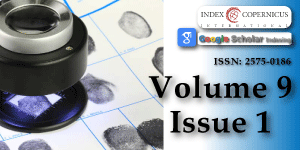Forensic Psychology and Criminal Profiling
Main Article Content
Abstract
Introduction: Forensic psychology plays a critical role in the criminal justice system, bridging the gap between psychology and law enforcement. One of its most significant applications is in criminal profiling, which involves the analysis of crime scene evidence, behavioral patterns, and psychological indicators to construct a profile of potential offenders. This study explores the intersection of forensic psychology and criminal profiling, focusing on how psychological principles aid in understanding and predicting criminal behavior.
Aim: The study aimed to evaluate the effectiveness and limitations of criminal profiling as a tool in criminal investigations, and to examine the methodologies that underpin profiling practices as a vital tool in the field of forensic sciences.
Methodology: Qualitative content analysis of documented criminal cases from reputable journals were reviewed for this study. Related articles were searched for from Google Scholar and Research Gate using the Keywords. A selection of high-profile cases where profiling significantly contributed to suspect identification were analyzed to assess the practical utility of psychological profiling.
Results: The results indicate that while criminal profiling is not a standalone solution, it offers valuable insights when integrated with traditional investigative techniques. Psychological constructs such as personality disorders, cognitive distortions, and behavioral consistency were found to be instrumental in building accurate profiles. However, the findings also highlight challenges including subjectivity, bias, and the risk of stereotyping, potentially compromising investigative objectivity.
Conclusion: Forensic psychology, through the application of criminal profiling, provides a powerful adjunct to investigative procedures. When used responsibly and in conjunction with empirical data and forensic evidence, profiling can enhance the efficiency and direction of criminal investigations. Continued research and standardization of profiling methodologies are essential to maximize its reliability and effectiveness in modern forensic practice. This study contributes to a deeper understanding of the practical roles and limitations of forensic psychology’s role in the pursuit of justice.
Article Details
Copyright (c) 2025 Eze SM, et al.

This work is licensed under a Creative Commons Attribution 4.0 International License.
Lonne B, Scott D, Higgins D, Herrenkohl TI. Re-visioning public health approaches for protecting children. In: Child maltreatment. 2019. Available from: https://link.springer.com/book/10.1007/978-3-030-05858-6
Menzie L. “ITT: Rape Analysts”: Hosting negotiations of consent, kink, and violence in virtual space. 2018. Available from: https://doi.org/10.22215/etd/2018-13198
Dwivedi YK, Hughes L, Baabdullah AM, Ribeiro-Navarrete S, Giannakis M, Al-Debei MM, et al. Metaverse beyond the hype: Multidisciplinary perspectives on emerging challenges, opportunities, and agenda for research, practice and policy. Int J Inf Manag. 2022;66:102542. Available from: https://www.sciencedirect.com/science/article/pii/S026840122200059X
Bartol CR, Bartol AM. Introduction to forensic psychology: Research and application. 5th ed. Thousand Oaks (CA): SAGE Publications; 2018.
American Psychological Association. Specialty guidelines for forensic psychology. Am Psychol. 2013;68(1):7–19. Available from: https://www.apa.org/practice/guidelines/forensic-psychology.pdf
Tapper S. Testing the assumption of behavioral consistency in a New Zealand sample of serial rapists [master’s thesis]. 2021. Available from: https://doi.org/10.26686/wgtn.16968520.v1
Snook B, Cullen RM, Bennell C, Taylor PJ, Gendreau P. The criminal profiling illusion: What's behind the smoke and mirrors? Crim Justice Behav. 2008;35(10):1257–1276. Available from: http://dx.doi.org/10.1177/0093854808321528
Melton GB, Petrila J, Poythress NG, Slobogin C. Psychological evaluations for the courts: A handbook for mental health professionals and lawyers. 4th ed. New York (NY): Guilford Press; 2017. Available from: https://www.guilford.com/excerpts/melton.pdf?t=1
Canter D. Mapping murder: The secrets of geographical profiling. London: Virgin Books; 2004. Available from: https://archive.org/details/mappingmurdersec0000cant
Geradts Z, Bree E, Keppens J, de Koster B. Artificial intelligence in forensic science: A review. Forensic Sci Int Synergy. 2019;1:54–62.
Keppel RD, Birnes WJ. The psychology of serial killer investigations: The grisly business unit. San Diego (CA): Academic Press; 2003. Available from: https://www.sciencedirect.com/book/9780124042605/the-psychology-of-serial-killer-investigations
Douglas JE, Olshaker M. The anatomy of motive: The FBI’s legendary Mindhunter explores the key to understanding and catching violent criminals. New York (NY): Gallery Books; 2024.
Ressler RK, Burgess AW, Douglas JE. Sexual homicide: Patterns and motives. Lexington (MA): Lexington Books; 1988. Available from: https://www.ojp.gov/ncjrs/virtual-library/abstracts/sexual-homicide-patterns-and-motives-0
Turvey BE. Criminal profiling: An introduction to behavioral evidence analysis. 4th ed. San Diego (CA): Academic Press; 2011.
Rossmo DK. Geographic profiling. Boca Raton (FL): CRC Press; 2000.
Mutawa NA, Bryce J, Franqueira VN, Marrington A, Read JC. Behavioral Digital Forensics Model: Embedding Behavioral Evidence Analysis into the investigation of digital crimes. Digit Investig. 2019;28:70–82. Available from: https://doi.org/10.1016/j.diin.2018.12.003
Meyerson D, MacDermott T, Mackenzie C. Procedural justice and relational theory. In: Routledge eBooks. 2020. Available from: https://doi.org/10.4324/9780429317248
Birzer M, Roberson C. Introduction to criminal investigation. Boca Raton (FL): CRC Press; 2018. Available from: https://doi.org/10.4324/9781439897485
Herve H, Yuille JC. The psychopath: Theory, research, and practice. New York (NY): Routledge; 2017. Available from: https://doi.org/10.4324/9781315085470
Karwowski M, Kaufman JC. The creative self: Effect of beliefs, self-efficacy, mindset, and identity. San Diego (CA): Academic Press; 2017. Available from: http://dx.doi.org/10.1016/C2015-0-07011-3
Freud S. Leonardo da Vinci. London: Routledge; 2018. Available from: https://www.routledge.com/Leonardo-da-Vinci/Freud/p/book/9780415253864?srsltid=AfmBOornwtsQAf4QXiBg4gevZUbl3jTcYkMG6Ph11shGYgb8kINWCsBt
Machado H, Granja R. Forensic genetics in the governance of crime. Cham: Springer Nature; 2020. Available from: https://library.oapen.org/handle/20.500.12657/23264
Resnick PJ. The Andrea Yates case: insanity on trial. Clev St L Rev. 2007;55:147. Available from: https://engagedscholarship.csuohio.edu/cgi/viewcontent.cgi?article=1174&context=clevstlrev
Crow CL. California Gothic: The dark side of the dream. Vol. 1. London: Anthem Press; 2024. Available from: https://books.google.co.in/books/about/California_Gothic.html?id=atGbzgEACAAJ&redir_esc=y
Douglas JE, Olshaker M. Mindhunter: Inside the FBI’s elite serial crime unit. New York (NY): Simon and Schuster; 2017. Available from: https://www.amazon.in/Mindhunter-Inside-Elite-Serial-Crime/dp/1501191969
Meissner SN, Braithwaite J, Thorne K, Martinez A, Lycett E. Indigenous feminist evaluation methods: a case study in “My Two Aunties.” Can J Program Eval. 2023;38(2):186–207. Available from: https://doi.org/10.3138/cjpe-2023-0042
Pritchett S, Moeller K. Can social bonds and social learning theories help explain radical violent extremism? Nordic J Criminol. 2022;23(1):83–101. Available from: https://doi.org/10.1080/2578983x.2021.1889133
Van Der Wolf M. Safeguarding the quality of forensic assessment in sentencing. In: Routledge eBooks. 2022. Available from: https://doi.org/10.4324/9781351266482
Warburton K, Stahl SM. Decriminalizing mental illness. Cambridge: Cambridge University Press; 2021. Available from: https://www.amazon.com/Decriminalizing-Mental-Illness-Katherine-Warburton/dp/1108826954

